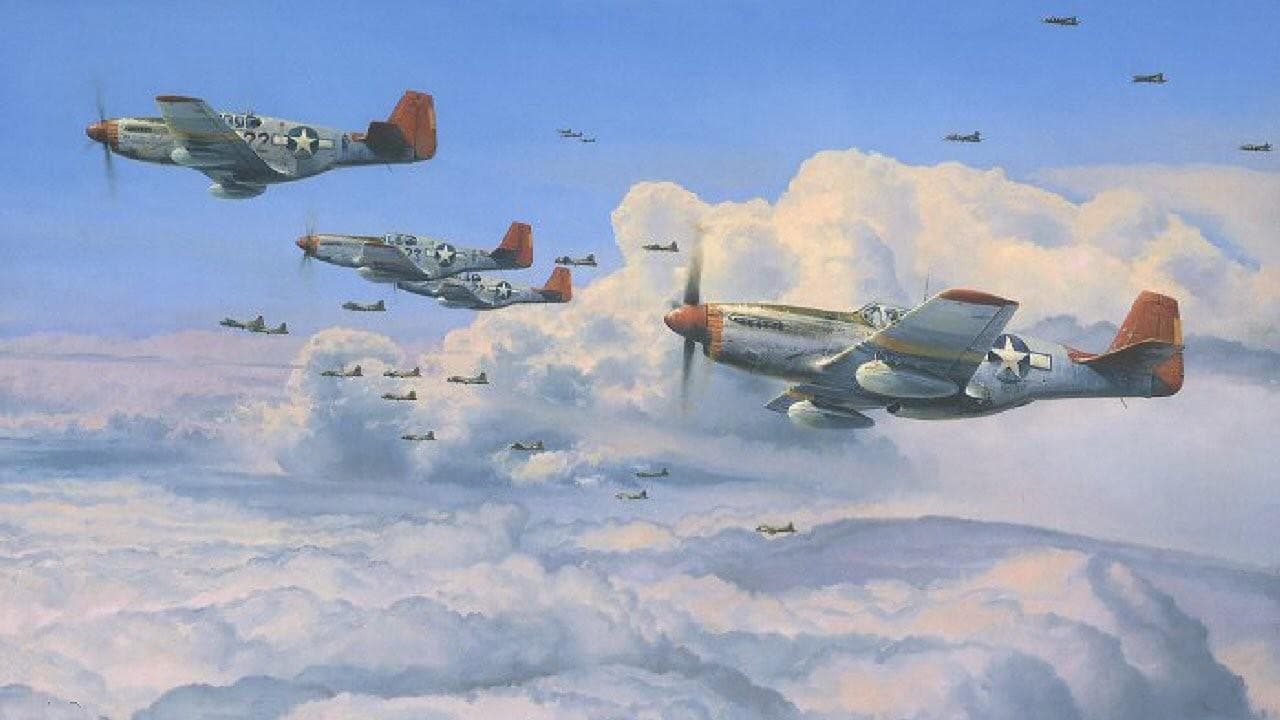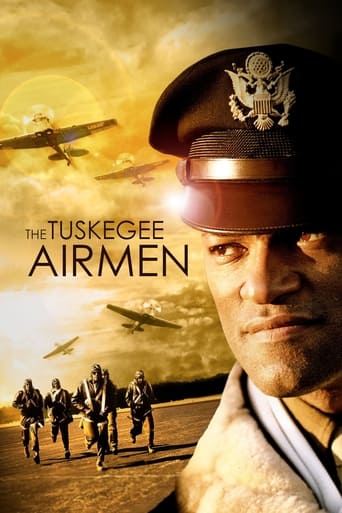Comwayon
A Disappointing Continuation
Frances Chung
Through painfully honest and emotional moments, the movie becomes irresistibly relatable
Wyatt
There's no way I can possibly love it entirely but I just think its ridiculously bad, but enjoyable at the same time.
Cheryl
A clunky actioner with a handful of cool moments.
dimplet
There was a time when I had never heard of the Tuskegee Airmen, but that was long ago, before this movie came out 20 years ago. I knew the basic facts from various sources, so the movie held no big surprises. But for those unfamiliar with the story, it will come as a revelation.The movie repeats the myth that no bombers were lost to enemy aircraft while being escorted by the Tuskegee Airmen. At the time, 1995, this was still believed to be true. But around 2004-2007, studies found 27 bombers were, in fact lost, still well below the average of 46 by comparable P-51 fighter groups. More astonishing to me is that they took on the new German ME 262 jet fighters and the ME 163 Komet rocket-powered fighters in a raid over Germany, shooting down three jets in one day! Now that would have been an exciting scene for the movie.I've been reading a book on the history of WWII, "Roosevelt's Centurions," and the movie's presentation of the issue of racism in the military seems to get the balance about right. It is so sad to look back upon the racial segregation in the American military in WWII, given we were fighting fascists who were racists. The movie makes this point well, especially with the accurate point of the preferential treatment of German POWs. But our Allies were often even more racist in their treatment toward black GIs overseas, so it was not as easy to solve as it might appear in hindsight. One of the interesting consequences of segregation was that the Army trained 16,000 black support personnel, along with black medical personnel, gunners and navigators. So it provided a skilled foundation for later military desegregation, ordered by President Truman in 1948.Roosevelt was constrained by political considerations, but his wife was not. Eleanor was quite a remarkable lady. Actually, during a visit to the Tuskegee Institute, she flew with the civilian flight instructor, C. Alfred "Chief" Anderson, not one of the recruits. (There's a photo of the two on Wikipedia.) Wikipedia: "In 1940, Anderson was recruited by the Tuskegee Institute in Alabama, to serve as the Chief Civilian Flight Instructor for its new program to train black pilots." This might explain the mystery of why the Army located this program in the Deep South. It sounds like the Institute was anticipating the war. Anderson had solid credentials: He created the Civilian Pilot Training for Howard University, Washington, D.C. in the late Thirties. Ironically, Anderson's flight instructor was the German-born Ernest H. Buehl, Sr. "Under Buehl's tutelage and personal insistence, in February 1932, Anderson became the first African American to receive an air transport pilot's license from the Civil Aeronautics Administration."The Tuskegee Airmen, like some other HBO historical movies -- Warm Springs and Truman -- is entertaining and thought provoking. It is historical fiction, not a documentary, but it seems to portray the historical period accurately. The original story was written by Captain Robert W. Williams, the fellow from Ottumwa, Iowa, who corresponded to Hannibal Lee, played by Laurence Fishburne. Aside from Col. Benjamin O. Davis, Jr., all the other characters are composites. Here is the tally of sacrifice by the Tuskegee Airmen, from Wikipedia:In all, 992 pilots were trained in Tuskegee from 1941 to 1946. 355 were deployed overseas, and 84 lost their lives in accidents or combat. The toll included 68 pilots killed in action or accidents, 12 killed in training and non-combat missions and 32 captured as prisoners of war.We owe all of the Tuskegee Airmen a debt of gratitude.
morgan_lefaye
I believe that this movie tells the story of the brave, the proud and the true, no matter their race. When the men were shot down, I cried, both because it was an emotional thing, and because I knew the real men these actors portrayed died fighting for our country, and their country, despite what others said.I don't know if the part when Peoples killed himself was true, but I know that he wanted to fight for his country more than anything, and they wouldn't let him. They took away his life. He just finished the job.When that white bomber pilot REQUESTED the 332nd, even after he spat at their feet(figuratively speaking of course), that made my heart soar. He was the best man in the tent, just because he didn't care if blacks were escorting them, as long as they were escorting them safely.If I sound cheesy, I don't care, because this movie made my day.
punxatawney
I think this movie is pretty great, has a good story and reflect the "tuskegee airmen" quite well. It's hard to imagine how they could put out with that sort of racism that occurred and they deserve bigger lines in the history books.however, I cannot overlook that some parts in the movie is somewhat historical inaccurate. First, when Lt. Glenn (Courtney B. Vance) speaks about his combat experience he says that he flied with the Canadian Air Force in England. It's so far right until the line when he says something like this: "I have shot down a Spitfire and been chased by a Hurricane" Anyone who has just a tiny bit of knowledge knows that the Spitfire belonged to the R.A.F(Royal Air Force) and the Canadians fought on the same side during the war so if he did what he claimed he would probably been in jail for treachery...;) Another thing is the aircraft they fly when they are in North Africa and Italy. The P-51D was an American fighter who went into service in 1944. If I don't remember wrong the movie takes place in 1943. But I can see why they used those aircrafts in the movie. Almost hundreds of these still fly today and since they flew the P-39 Airacobra and the P-47 Thunderbolt who hasn't got so many copies of them flying today and there were no advanced computer techniques who could animate aircraft(at least I think so) so I can understand why they choose the P-51.That's the only thing I can find in this movie that is really wrong!:PAnything else in this movie is fantastic! :D
hlcepeda
Consider this scenario: The powers-that-be (ostensibly with every good intention), having offered a select group of talented African-Americans the vehicle by which they could prove themselves, then proceed to undermine the laudable efforts of those very same African-Americans. What I have described is one of the major underpinnings of The Tuskegee Airmen.Sadly, I have also described what occurred in said film's creation and production process.Thwarted and hobbled by truncated events, a rather thin, basic script, embarrassingly cartoonish air combat dialogue, pedestrian direction, dicey editing, some poor continuity, and a woefully anemic budget, this HBO attempt never reaches the lofty heights that it otherwise could have attained, never realizes what should have been - and what history deserved. The acting notwithstanding, the end result of this unpolished affair amounted to nothing more than an errand list being checked off; such was the quality of the production value. Apart from the "live" air-to-air action, the battle scenes are populated by enough unrestored and colorized WWII stock footage to have temporarily drained the National Archives. Adding further insult, the production elves carelessly managed to drop in approximately five seconds of Vietnam carpet-bombing footage; no excuse here could ever suffice.Only the impassioned performances of key cast members truly propel this film - at least getting it off the sticky tarmac, but not far enough to fully complete its mission. Noteworthy, though, is Laurence Fishburne as the crazy-for-flying Hannibel Lee Jr., Christopher McDonald as the racist major, dubiously named Sherman Joy, Courtney B. Vance as the pragmatic Lt. Jeffrey Glenn, and - most noteworthy of all - Andre Braugher as Lt. Col. Benjamin O. Davis. I dare anyone to ignore Mr. Braugher when he is running at full-throttle. He is, arguably, this country's best actor, and it is impossible to take your eyes off of him. What a waste of talent!This tragic squandering is compounded by the fact that a feature drama - anything other than a documentary - was 50 years in coming; now that it has been made, its very existence may defer a proper telling for a long time to come. The significance and gravity of the subject matter deserved a rousing, blockbuster treatment - which broaches this question: why would an unmitigated disaster (both historically and in film content) such as 2001's Pearl Harbor warrant such a great influx of attention and funding, while a story of victory on all levels be denied so much? Anyone interested in answers should look to Hollywood, the almighty marketing and demographics gods, and maybe the other Maj. Joys still out there.My personal peccadillos aside, in first approaching The Tuskegee Airmen, I feared my penchant for military aviation and historical fairness would pervert my (hopefully) objective critique and unduly merit this HBO effort. On both points, my fears were far off-target. Performances? Within effective range! A good hit! 9 out of 10. Production? A dud! Call out the bomb squad! 3 out of 10. Overall Rating: 6.0

